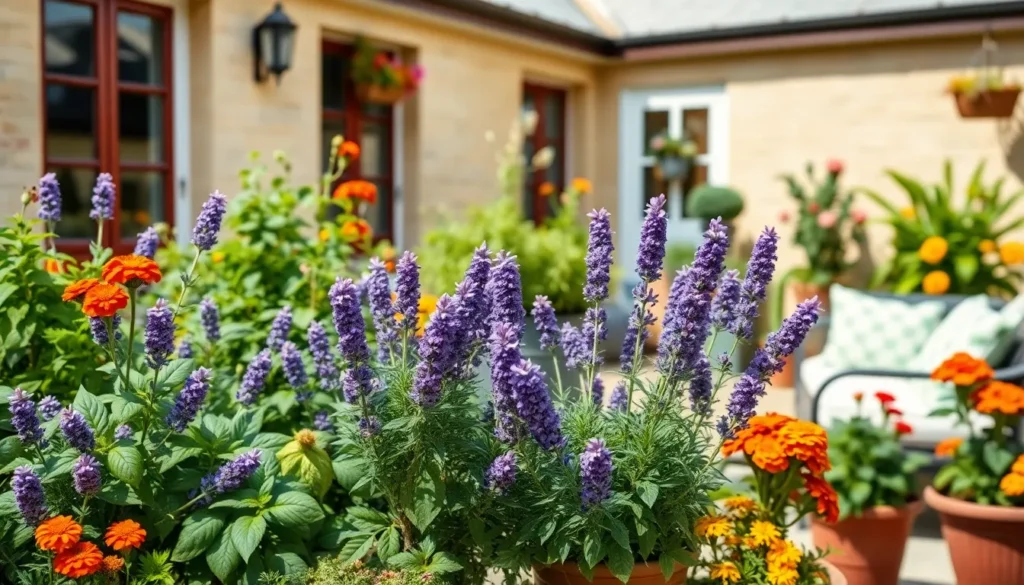Nothing ruins a peaceful evening on the patio quite like swarms of mosquitoes and buzzing flies disrupting our outdoor relaxation. While chemical bug sprays offer temporary relief, they’re not always the most pleasant or eco-friendly solution for our outdoor living spaces.
We’ve discovered that nature provides its own powerful pest control system through exact plants that naturally repel insects. These bug-repellent plants don’t just keep unwanted visitors away – they also add beauty, fragrance, and functionality to our patio gardens.
By strategically placing the right combination of insect-deterring plants around our outdoor spaces, we can create a natural barrier that keeps mosquitoes, flies, and other pests at bay. The best part? These plants work around the clock, releasing their protective compounds without any effort from us while improving our patio’s aesthetic appeal.
Choose Lavender for Natural Mosquito Defense
Lavender stands out as one of the most effective bug repellent plants for patios, combining powerful mosquito deterrent properties with stunning purple blooms and therapeutic fragrance. We’ve found that this Mediterranean herb contains natural compounds like linalool and linalyl acetate that mosquitoes find particularly offensive, making it an excellent addition to our outdoor pest control strategy.
Plant in Well-Draining Soil
Establish your lavender in sandy or rocky soil that drains water quickly to prevent root rot and promote healthy growth. We recommend mixing perlite or coarse sand into heavy clay soils to improve drainage, as waterlogged conditions can kill lavender plants within weeks. Test your soil pH to ensure it falls between 6.5 and 7.5, since lavender thrives in slightly alkaline conditions that enhance its natural oil production. Add limestone or wood ash to acidic soils to raise the pH level and create optimal growing conditions for maximum mosquito repelling effectiveness.
Position in Full Sun Areas
Select locations that receive at least 6 to 8 hours of direct sunlight daily to maximize lavender’s essential oil production and mosquito deterrent strength. We place our lavender plants along south facing patio edges and garden borders where they can soak up morning and afternoon sun exposure. Space individual plants 12 to 18 inches apart to ensure adequate air circulation and prevent fungal diseases that can weaken their pest repelling capabilities. Avoid shaded areas under trees or covered porches, as insufficient sunlight reduces the concentration of aromatic compounds that keep mosquitoes away.
Harvest for DIY Repellent Sprays
Cut lavender stems in the early morning after the dew has dried but before the heat of the day diminishes essential oil concentrations. We harvest our lavender flowers just as they begin to open, typically in mid to late summer, when their mosquito repelling oils reach peak potency. Bundle fresh stems together and hang them upside down in a dry, well ventilated area for 2 to 3 weeks to preserve their natural insect deterrent properties. Steep dried lavender flowers in witch hazel or vodka for 2 weeks to create a natural mosquito spray that we can apply to skin or spray around our patio areas.
Add Citronella Grass for Powerful Protection
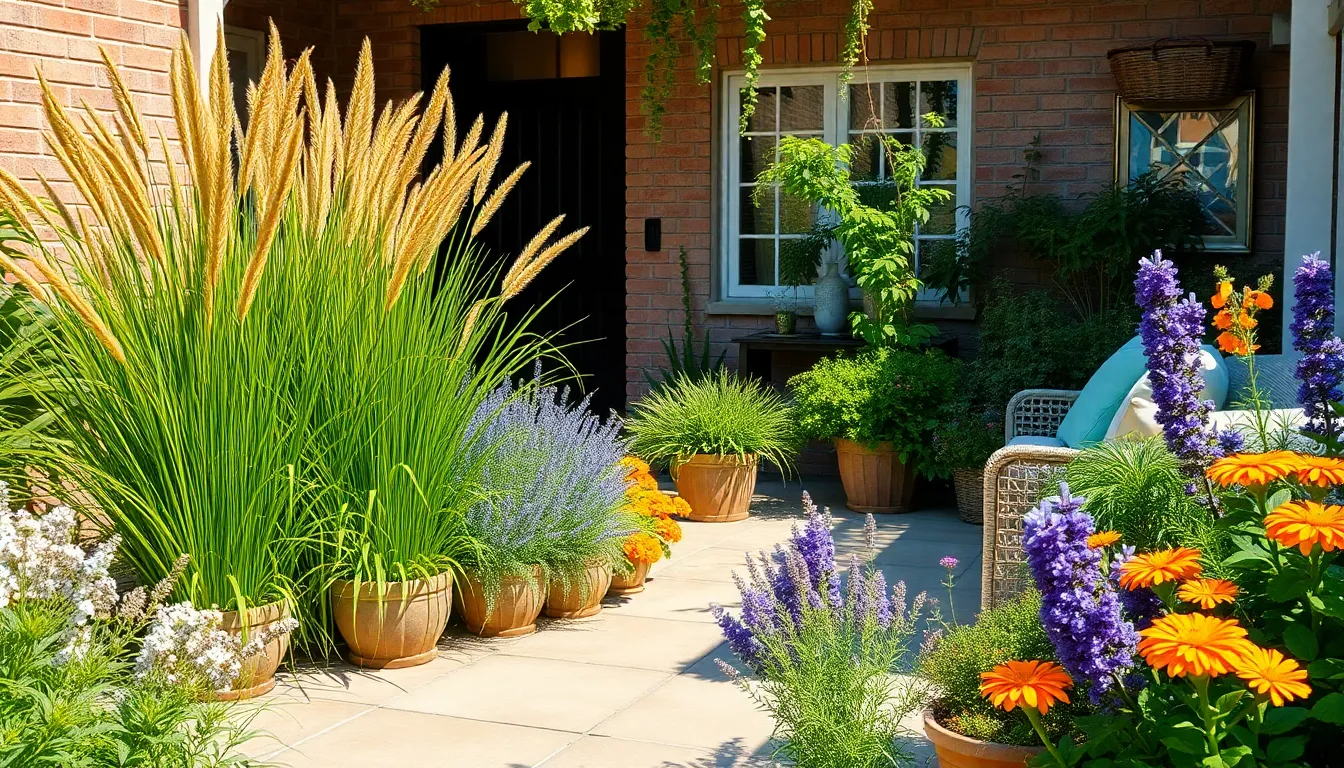
Citronella grass stands as the most widely recognized mosquito repelling plant, delivering powerful protection through its strong, pungent aroma that masks scents attracting these pests. We can create an effective natural barrier by incorporating this remarkable plant into our patio design.
Select Hardy Varieties for Your Climate
Choose climate appropriate varieties to ensure your citronella grass thrives and produces the aromatic compounds necessary for repelling insects. We’ll want to consider plants like catmint (Nepeta), which proves hardy in zones 3-8 and demonstrates effectiveness up to ten times greater than chemical repellents like DEET.
Research your exact growing zone before selecting companion plants that work alongside citronella grass. Options such as lavender, rosemary, basil, and marigolds provide additional pest repelling benefits while adding vibrant colors and delightful fragrances to our outdoor spaces.
Test soil conditions in your intended planting areas to determine which varieties will establish successfully. We can maximize our protection by combining citronella with other climate suited aromatic plants that complement its mosquito deterring properties.
Space Plants Appropriately for Growth
Plan adequate spacing between citronella grass and neighboring plants to allow proper air circulation and prevent overcrowding issues. We need to remember that plants like catmint can spread aggressively, requiring sufficient room to grow without competing with nearby vegetation.
Position citronella strategically near patio entrances and seating areas where we spend the most time outdoors. Grouping citronella with marigolds and other repellent plants in these high traffic zones maximizes their protective coverage.
Allow room for mature growth when establishing your citronella plantings, as these grasses can reach substantial sizes. We should consider the full grown dimensions of each plant to avoid future transplanting or pruning complications.
Maintain Through Regular Watering
Establish consistent watering schedules to support healthy foliage and sustain the production of essential oils responsible for repelling bugs. We can ensure our citronella grass maintains its protective properties by providing regular hydration, especially during dry periods.
Monitor soil moisture levels to prevent both drought stress and overwatering conditions that lead to fungal problems or root rot. Most bug repellent plants perform best with moderate, consistent moisture rather than sporadic heavy watering sessions.
Adjust watering frequency based on seasonal weather patterns and rainfall amounts in your area. We’ll find that maintaining proper hydration levels helps our citronella grass produce stronger aromatic compounds that effectively deter mosquitoes and other flying pests.
Install Marigolds as Colorful Pest Barriers

We’ll transform our patio into a vibrant pest-free zone with marigolds, nature’s most reliable colorful defenders against mosquitoes and garden pests.
Pick French or African Varieties
Choose French marigolds (Tagetes patula) for compact, versatile pest control. These annuals grow just 6–12 inches tall and produce vibrant yellow, orange, red, or bicolor flowers that emit powerful pest-deterring scents. French varieties work exceptionally well in smaller patio spaces where we need maximum impact without overwhelming our outdoor décor.
Select African marigolds (Tagetes erecta) when we want taller, more robust pest barriers. These varieties provide stronger visual impact and broader pest protection coverage for larger patio areas. Both types release distinctive scents that repel mosquitoes, aphids, thrips, whiteflies, Mexican bean beetles, squash bugs, and tomato hornworms while their roots produce chemicals toxic to harmful nematodes.
Plant in Containers for Easy Movement
Position marigolds in containers or pots for strategic pest control placement. This container approach allows us to move plants easily around our patio, positioning them near entrances, seating areas, and dining spaces where pest protection matters most. We can relocate containers as needed to follow sun patterns or create targeted pest barriers for exact outdoor activities.
Create mobile pest defense systems by grouping multiple containers. Strategic container placement near doorways and gathering spots maximizes the pest-repelling benefits while maintaining our patio’s aesthetic appeal. Container growing also prevents marigolds from spreading aggressively into unwanted areas while keeping their pest-fighting properties contained exactly where we need them most.
Deadhead Regularly for Continuous Blooms
Remove spent flowers consistently to encourage prolonged blooming throughout the growing season. Regular deadheading ensures our marigolds continue producing their pest-repelling scent while maintaining their colorful visual appeal. This simple maintenance task keeps plants focused on creating new flowers rather than setting seeds.
Schedule weekly deadheading sessions to maintain peak pest protection. Fresh blooms produce the strongest scents that deter mosquitoes and other garden pests most effectively. Consistent flower removal also prevents plants from becoming leggy or declining in appearance, ensuring our patio maintains both pest control functionality and attractive garden beauty throughout the entire growing season.
Grow Basil for Dual-Purpose Benefits
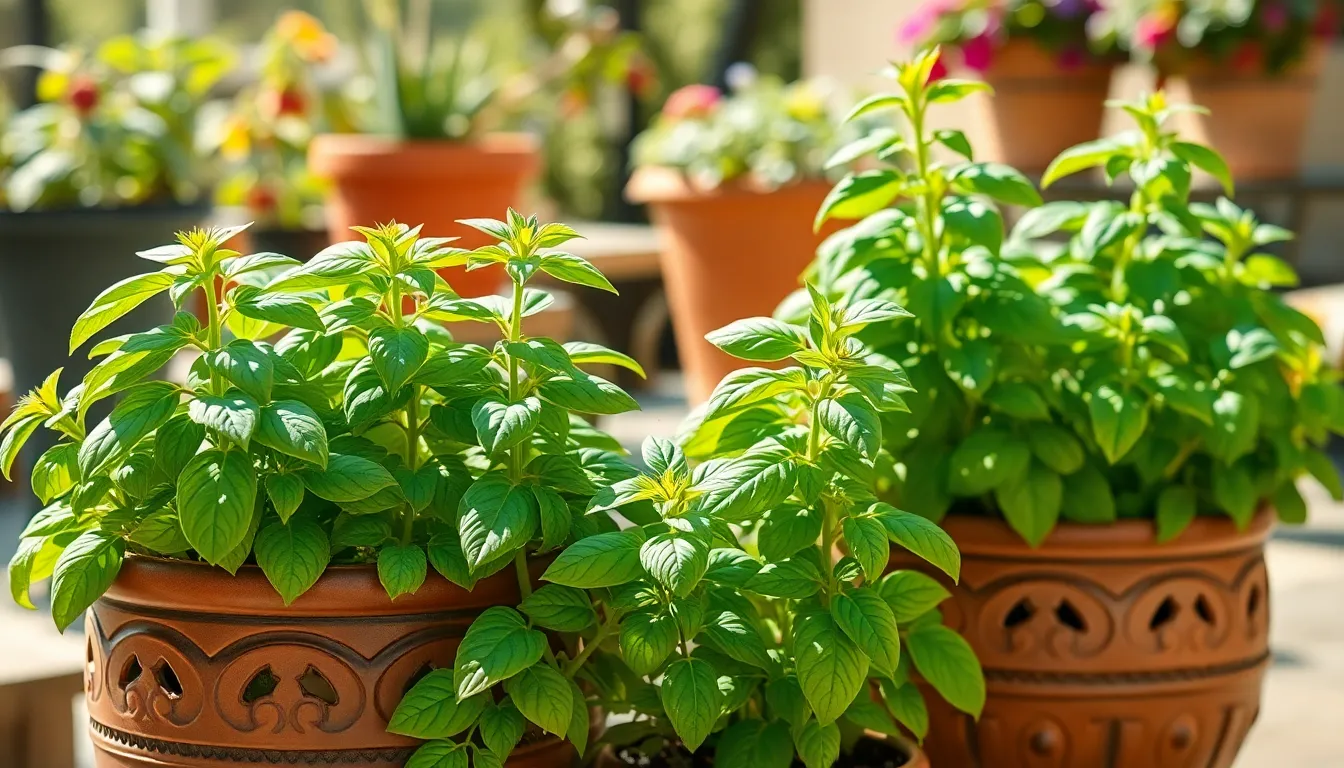
Basil stands as one of our most versatile bug repellent plants for patios, combining exceptional culinary value with powerful natural pest control. We can enjoy fresh herbs for cooking while keeping mosquitoes and flies away from our outdoor spaces through basil’s aromatic compounds like citronellol.
Choose Sweet Basil or Lemon Basil
Sweet basil varieties offer the classic aromatic scent that we recognize from Italian cuisine, making them perfect for dual purpose patio growing. We’ll find that sweet basil’s traditional fragrance effectively deters insects while providing abundant leaves for cooking. Lemon basil brings a citrusy twist to our patio gardens, carrying a lighter aroma that may attract fewer pests than other varieties. Both types thrive in containers and outdoor spaces, contributing significantly to reducing bug populations in our patio areas.
Provide Adequate Drainage Systems
Drainage becomes critical for basil’s health and bug repelling effectiveness on our patios. We must ensure our pots and garden beds have proper drainage to maintain moist but well drained soil conditions. Root rot prevention through adequate drainage keeps our basil plants healthy and productive, improving their ability to produce the fragrant leaves that naturally repel insects. Waterlogged soil weakens basil plants and reduces their pest deterrent properties.
Pinch Flowers to Maintain Leaf Production
Pinching basil flowers regularly encourages our plants to focus energy on leaf growth rather than seed production. We’ll notice more abundant leaves and stronger scent when we consistently remove flower buds as they appear. This practice improves both our culinary yield and the plant’s insect repelling effectiveness throughout the growing season. Regular flower removal keeps basil plants bushy and productive, maximizing their dual benefits on our patios.
Plant Peppermint for Strong Scent Barriers
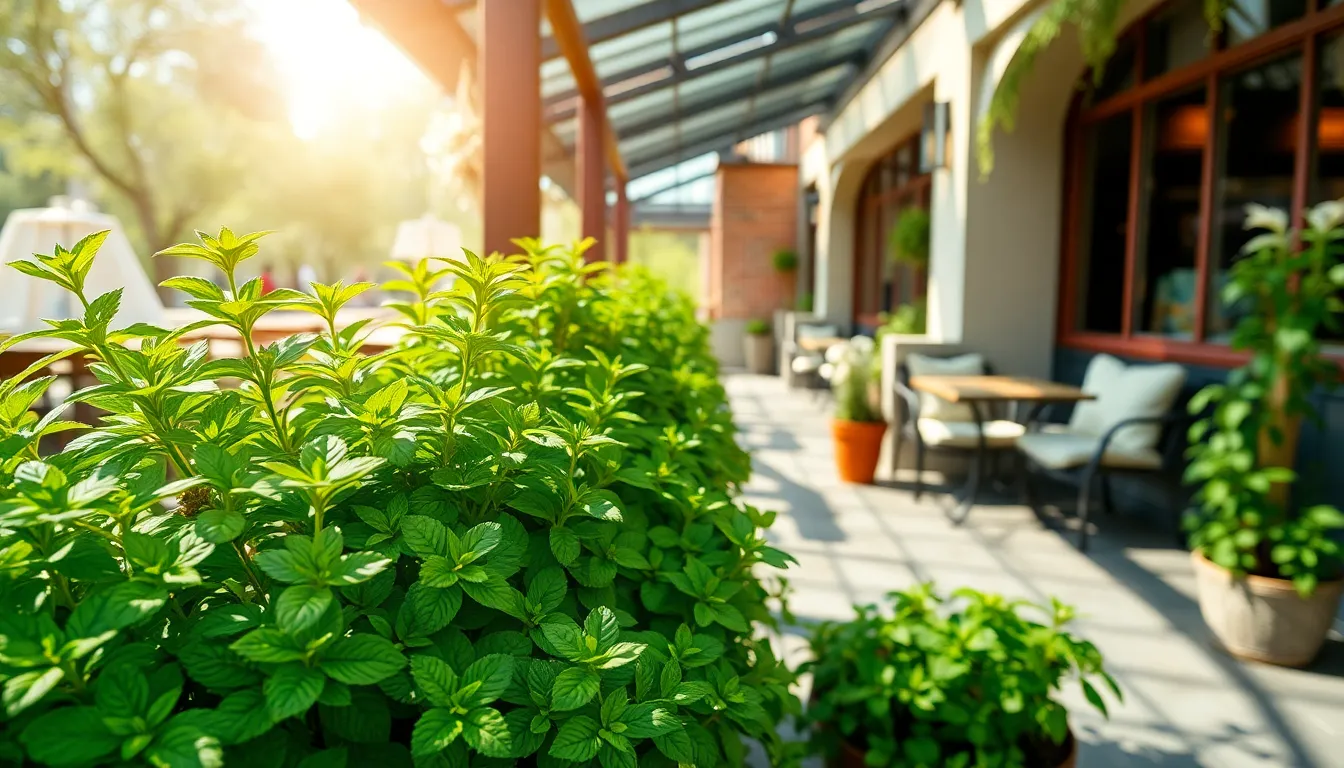
Peppermint delivers powerful bug repelling properties through its menthol-rich scent that naturally deters mosquitoes and other insects. We find this aromatic herb creates an effective natural barrier when positioned strategically around our patio spaces.
Contain in Pots to Prevent Spreading
Peppermint spreads aggressively when planted directly in garden soil, making container growing our preferred method for patio bug control. We recommend using pots or planters to prevent this vigorous herb from overtaking nearby plants. Container growing also allows us to move our peppermint plants to different locations around the patio for maximum pest deterring effectiveness. Strategic placement near seating areas and entry points enhances the protective barrier against insects.
Water Consistently for Healthy Growth
Consistent moisture supports vigorous leaf production in peppermint plants, which directly enhances their scent and repellent properties. We maintain regular watering schedules to keep the soil evenly moist but not waterlogged. Healthy peppermint plants with lush foliage release stronger essential oils that effectively repel bugs from our outdoor spaces. Monitor soil moisture levels daily during hot weather to ensure optimal growing conditions.
Trim Regularly to Encourage Bushiness
Regular trimming encourages denser, bushier peppermint growth that increases the leaf surface area releasing bug repelling oils. We pinch back stems frequently to prevent legginess and promote continuous new growth. Trimming also prevents flowering, which redirects the plant’s energy into producing more aromatic foliage. Harvest leaves regularly for cooking or drying, as this pruning action stimulates fresh growth and maintains the plant’s pest deterring effectiveness throughout the growing season.
Position Rosemary as Perennial Protection
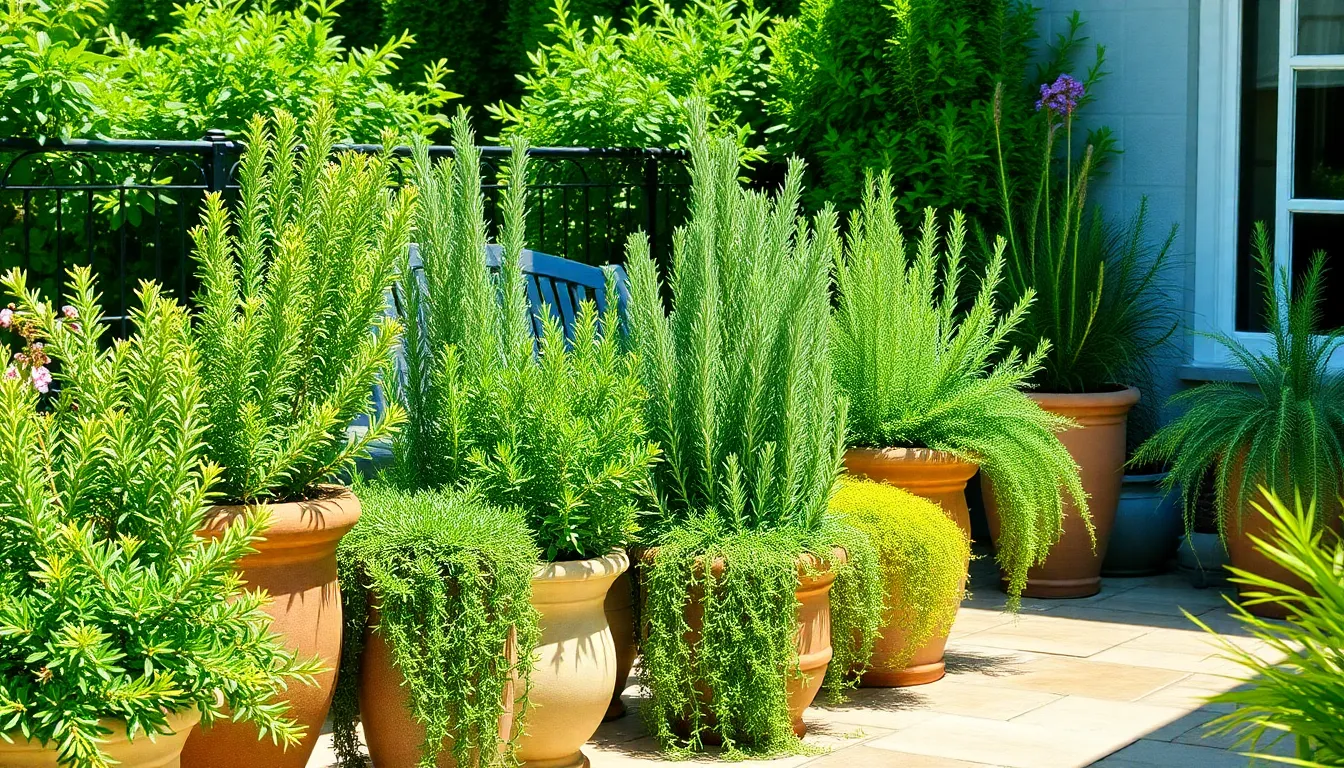
Rosemary stands out as our top choice for year-round patio bug protection, offering reliable defense against mosquitoes, ticks, cabbage moths, and carrot flies through its woody, aromatic scent. This hardy evergreen herb creates a fragrant barrier that pests naturally avoid, making it perfect for placing near outdoor seating areas or along patio borders.
Select Upright or Trailing Varieties
Upright rosemary varieties work exceptionally well as decorative borders or standalone container plants on patios. These sturdy plants maintain their shape while delivering consistent insect-repelling benefits throughout the growing season. We recommend positioning upright varieties strategically around seating areas where their aromatic oils can effectively interfere with insects’ ability to locate hosts.
Trailing rosemary varieties offer unique design flexibility for elevated planters and hanging baskets. These cascading types create beautiful living curtains that provide both aesthetic appeal and bug protection from above. Hanging trail varieties near patio entrances maximizes their protective coverage while adding vertical interest to outdoor spaces.
Ensure Proper Winter Protection
Container grown rosemary requires special winter care in climates outside USDA zones 7-10 to maintain its perennial bug-repelling benefits. We need to bring potted rosemary indoors before the first hard frost or provide adequate insulation for outdoor containers. Moving plants to unheated garages, greenhouses, or sunny indoor locations ensures survival through harsh winter months.
Insulation techniques for outdoor containers include wrapping pots in burlap, surrounding them with mulch, or grouping multiple containers together for shared warmth. These protection methods help rosemary plants survive cold temperatures while preserving their essential oil production for the following growing season.
Prune After Flowering Season
Post flowering pruning encourages bushier growth and maintains rosemary’s shape, directly improving its scent production and insect-repelling effectiveness. We should trim rosemary plants after their blooming period ends, typically in late spring or early summer depending on the variety. This timing allows plants to recover and produce new aromatic growth before winter dormancy.
Regular trimming prevents woody stems from overgrowing and keeps plants healthy and productive throughout their lifespan. Removing spent flowers and cutting back leggy branches by one-third maintains optimal essential oil concentration in the foliage. Fresh growth produces the strongest aromatic compounds that create the most effective natural barrier against patio pests.
Create Strategic Layout Plans for Maximum Coverage

We’ll maximize our patio’s pest protection by designing thoughtful plant arrangements that ensure comprehensive coverage while maintaining healthy growing conditions.
Group Plants by Watering Needs
Organizing plants by their water requirements prevents maintenance disasters and keeps our bug repelling garden thriving. Drought tolerant champions like lavender and rosemary work perfectly together since they prefer less frequent watering. These Mediterranean herbs share similar soil preferences and won’t suffer from our tendency to underwater rather than overwater.
Moisture loving plants like basil and marigolds form their own watering group for consistent care. We’ll place these together in areas where we can easily monitor soil moisture levels. French marigolds paired with sweet basil create beautiful combinations that bloom from late spring until frost while requiring similar watering schedules.
Strategic grouping saves time and prevents the common mistake of killing drought tolerant plants with too much water. Peppermint containers can move independently since this aggressive spreader needs frequent watering but shouldn’t share root space with other plants. Citronella grass joins the moderate water group alongside our herb selections.
Consider Height and Spread Requirements
Layering plants by mature size creates visual appeal while maximizing our pest repelling surface area. Tall citronella grass and lavender varieties serve as backdrop “thrillers” that can reach 3 to 6 feet in height. These towering sentinels work best positioned at the back of garden beds or in large statement containers.
Medium height plants like marigolds and basil function as reliable “fillers” throughout our layout. African marigolds can grow 12 to 36 inches tall while French marigolds stay compact at 6 to 12 inches, giving us flexibility for different patio zones. Rosemary’s upright varieties provide consistent medium height structure year round.
Ground level coverage comes from trailing varieties and compact selections that eliminate hiding spots for pests. Trailing rosemary spills beautifully from elevated planters while providing lower level protection. We’ll arrange odd numbered plant groupings for natural visual flow that maximizes scent distribution across our entire patio space.
Leave Access Paths for Maintenance
Clear pathways between our bug repelling plants ensure we can reach every corner for proper care. We’ll design 18 to 24 inch wide access routes that allow comfortable movement for watering, pruning, and plant inspection. These maintenance corridors prevent us from trampling plants or neglecting hard to reach areas.
Regular access keeps our plants healthy and their pest repelling properties at peak effectiveness. Morning harvesting of lavender stems requires easy approach routes, while deadheading marigolds throughout the growing season demands convenient positioning. Rosemary’s post flowering pruning becomes simple when we can reach all sides of each plant.
Strategic spacing maintains air circulation while providing maintenance access for container arrangements. We’ll position moveable pots with enough space for seasonal rearrangement and winter protection needs. This flexibility lets us optimize sun exposure throughout the year while ensuring our 6 to 8 hours of daily sunlight requirements stay met for maximum essential oil production.
Maintain Your Bug Repellent Garden
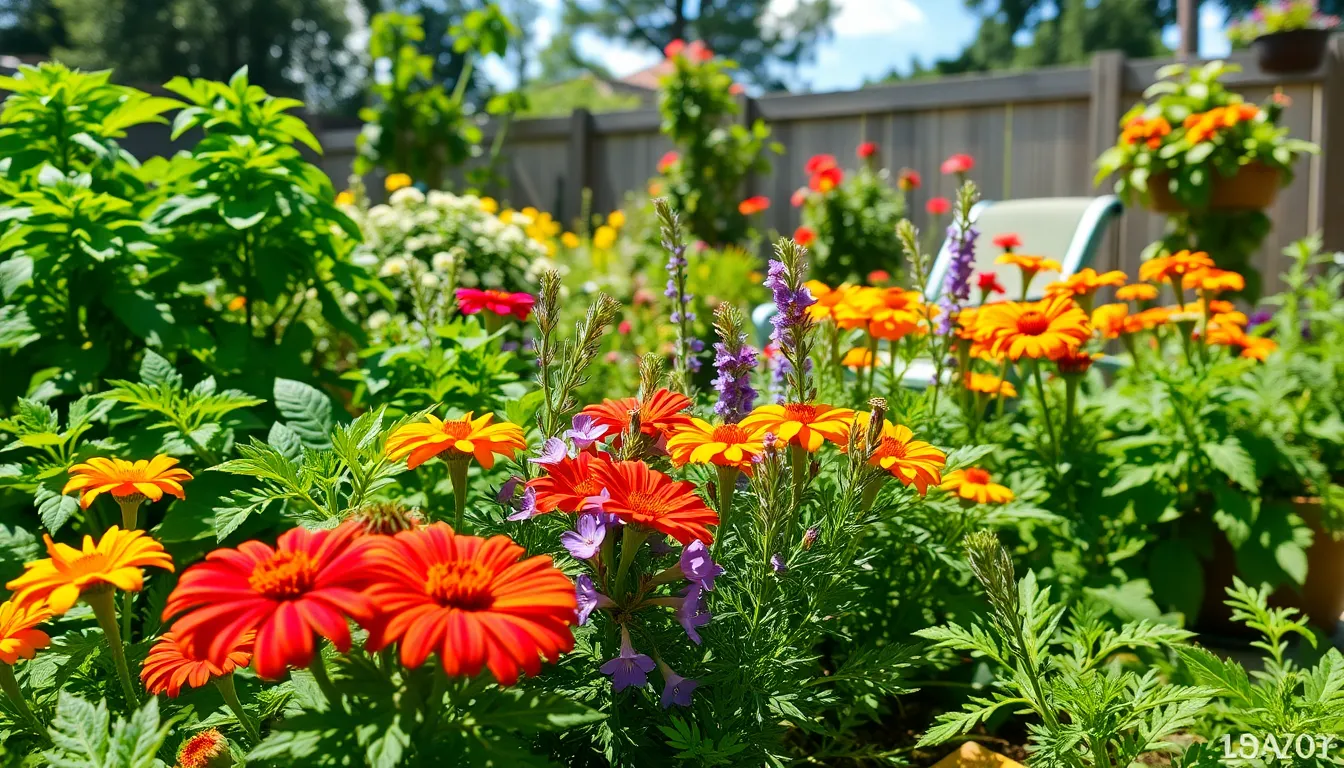
Proper maintenance ensures our bug repellent plants continue delivering effective pest protection throughout the growing season. Strategic care routines maximize the essential oil production that keeps mosquitoes and other insects away from our patio spaces.
Follow Seasonal Care Schedules
Spring care begins with preparing our plants for active growth by fertilizing herbs like basil and mint with balanced nutrients. We’ll increase watering frequency as temperatures rise and daylight hours extend, supporting robust foliage development in citronella grass and other moisture-loving plants.
Summer maintenance focuses on consistent watering schedules, especially for container-grown lavender and rosemary during hot, dry periods. Deep watering sessions twice weekly work better than daily light watering for most bug repellent plants, encouraging strong root systems that support healthy essential oil production.
Fall preparation involves reducing fertilizer applications while maintaining regular watering until the first frost threatens tender plants like basil. We’ll harvest seeds from marigolds and nasturtiums before cold weather arrives, ensuring fresh plantings for the following season.
Winter protection requires moving tender container plants indoors or providing insulation for hardy perennials like rosemary in colder climates. Mulching around established plants protects root systems from temperature fluctuations that could weaken their pest-repelling properties.
Monitor for Plant Health Issues
Pest identification starts with weekly inspections of leaf undersides and stems where aphids, spider mites, and whiteflies commonly hide. Early detection prevents infestations that weaken plants and reduce their natural bug-repelling compounds like eucalyptol in basil and citronellal in lemon balm.
Disease prevention requires checking for yellowing leaves, black spots, or powdery mildew that indicate fungal problems affecting plant health. Proper air circulation between plants prevents most fungal issues, while avoiding overhead watering reduces moisture on leaves that encourages disease development.
Nutrient deficiency signs appear as pale or yellowing leaves, stunted growth, or reduced flowering in marigolds and other blooming repellent plants. Yellowing lower leaves often indicate nitrogen deficiency, while purple leaf edges suggest phosphorus problems that affect essential oil production.
Stress indicators include wilting during cool periods, leaf drop, or reduced aromatic intensity in herbs like mint and lemon balm. Environmental stresses like inconsistent watering or extreme temperatures compromise the plants’ ability to produce the compounds that repel mosquitoes and other pests.
Replace Annuals Each Growing Season
Annual plant identification includes basil, marigolds, and nasturtiums that complete their life cycle in one growing season and require replanting each year. These plants typically decline in effectiveness as they age, making fresh plantings essential for maintaining strong pest-repelling properties.
Seed collection timing occurs when marigold flower heads turn brown and dry, while nasturtium seeds develop visible size and firmness on the plant. We’ll gather basil seeds after flower spikes mature and turn brown, storing them in cool, dry conditions for spring planting.
Replacement scheduling begins with starting seeds indoors 6 to 8 weeks before the last expected frost date in our area. Direct seeding works well for marigolds and nasturtiums in warm soil after frost danger passes, while basil transplants establish more successfully than direct-sown seeds.
Succession planting involves sowing new basil seeds every 2 to 3 weeks throughout the growing season, ensuring continuous harvests and peak pest-repelling effectiveness. Staggered plantings provide fresh, vigorous plants that produce maximum essential oils for natural mosquito and fly deterrence around our patio spaces.
Conclusion
Creating a naturally pest-free patio doesn’t require harsh chemicals or expensive treatments. We’ve shown you how strategic placement of bug-repellent plants like lavender citronella marigolds and rosemary can transform your outdoor space into both a beautiful garden and an effective insect barrier.
The key to success lies in understanding each plant’s exact needs and maintaining them properly throughout the growing season. With consistent care and thoughtful arrangement these natural defenders will provide reliable protection while improving your patio’s visual appeal.
Your outdoor sanctuary awaits – it’s time to let nature’s own pest control answers work for you while creating the relaxing space you deserve.
Frequently Asked Questions
What plants naturally repel mosquitoes and flies?
The most effective mosquito and fly repelling plants include lavender, citronella grass, marigolds, basil, peppermint, and rosemary. These plants contain natural compounds and essential oils that deter insects while adding beauty and fragrance to your outdoor spaces. Lavender contains linalool and linalyl acetate, while citronella masks scents that attract pests.
How do I grow lavender for mosquito control?
Plant lavender in well-draining sandy or rocky soil with a pH between 6.5 and 7.5. Choose a location that receives 6-8 hours of direct sunlight daily. Space plants properly to ensure good air circulation and prevent diseases. You can harvest lavender stems in the morning and dry them to create DIY mosquito repellent sprays.
Where should I place citronella grass for maximum effectiveness?
Position citronella grass near patio entrances and seating areas for optimal protection. Choose climate-appropriate varieties and ensure proper spacing between plants for air circulation. Regular watering is essential to maintain healthy foliage and essential oil production. Consider companion planting with catmint, lavender, rosemary, basil, and marigolds for enhanced benefits.
Which marigold varieties work best for pest control?
French marigolds are ideal for smaller spaces due to their compact size and vibrant blooms. African marigolds work better for larger areas, providing stronger visual impact and broader pest protection. Plant marigolds in containers for easy movement and strategic placement. Regular deadheading encourages continuous blooming and maintains pest-deterring scents.
How do I maintain basil plants for bug repelling?
Ensure proper drainage as waterlogged soil weakens plants and reduces pest-repelling properties. Sweet basil and lemon basil are recommended varieties that offer both culinary value and insect deterrence. Regularly pinch off flowers to encourage leaf growth and enhance the plant’s ability to repel insects while providing fresh herbs for cooking.
Why should I grow peppermint in containers?
Growing peppermint in pots prevents aggressive spreading while allowing strategic placement around patios for maximum effectiveness. The menthol-rich scent deters mosquitoes and other insects. Consistent watering supports healthy growth and enhances repellent properties. Regular trimming encourages bushier growth and maintains pest-deterring effectiveness throughout the growing season.
How do I care for rosemary as a year-round pest deterrent?
Choose upright varieties for decorative borders or trailing varieties for hanging baskets. In colder climates, provide winter protection for container-grown rosemary using insulation techniques. Prune after flowering season to encourage bushier growth and maintain optimal essential oil concentration. Rosemary effectively deters mosquitoes, ticks, cabbage moths, and carrot flies.
How should I arrange these plants for maximum pest coverage?
Group plants based on watering needs – pair drought-tolerant plants like lavender and rosemary together, while grouping moisture-loving plants like basil and marigolds. Consider height and spread requirements for visual appeal and maximum pest-repelling surface area. Create clear access paths for maintenance to ensure healthy plant care and optimal effectiveness.
What maintenance do bug-repellent plants require?
Follow seasonal care schedules with appropriate fertilization and watering routines. Monitor plant health regularly for pests, diseases, and nutrient deficiencies. Replace annual plants each growing season to maintain strong pest-repelling properties. Collect seeds and practice succession planting to ensure continuous harvests and effective pest protection throughout the season.

